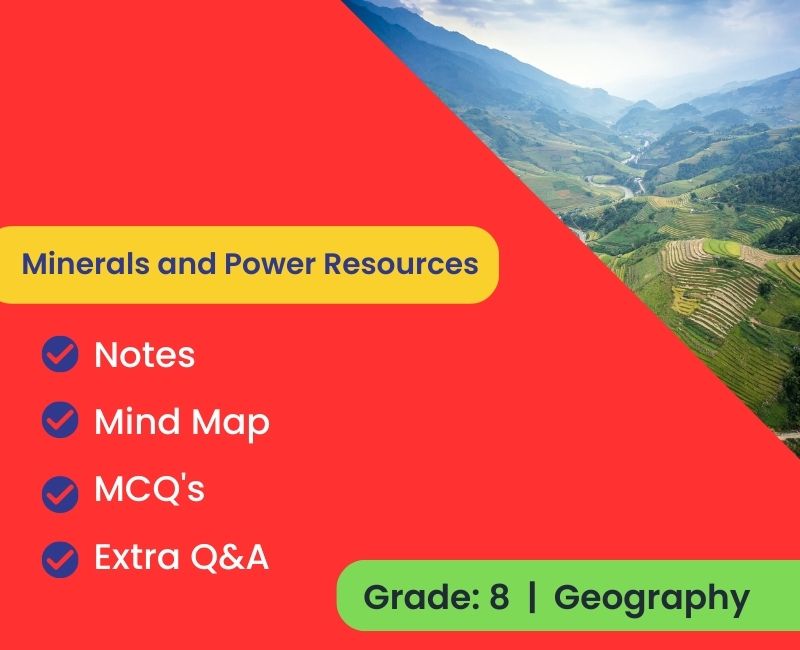Complete Notes, MCQs, and Extra Questions for Class 8 Geography Chapter 3 Minerals and Power Resources
If you're a student in Class 8 Geography, you may be studying Chapter 3 on Minerals and Power Resources. This chapter covers important topics such as types of minerals, distribution of minerals in India, and different sources of power. Our guide provides you with notes, MCQs, and extra questions and answers to help you understand and master this chapter.
Introduction to Minerals and Power Resources.
Minerals and power resources are essential for the development of any country. Minerals are naturally occurring substances that are found in the earth's crust. They are used in various industries such as construction, manufacturing, and energy production. Power resources, on the other hand, are sources of energy that are used to generate electricity. They include both conventional sources such as coal, oil, and natural gas, as well as renewable sources such as wind, solar, and hydro power. In this chapter, we will explore the different types of minerals and power resources and their distribution in India.
Types of Minerals and their Distribution.
There are various types of minerals found in India, including metallic minerals such as iron, copper, and gold, and non-metallic minerals such as limestone, mica, and gypsum. These minerals are distributed unevenly across the country, with some states having a higher concentration of certain minerals than others. For example, Jharkhand is known for its rich deposits of iron ore, while Rajasthan is known for its reserves of mica and copper. Understanding the distribution of minerals is important for the development of industries and the economy as a whole.
Conservation of Minerals.
Conservation of minerals is an important aspect of sustainable development. Minerals are non-renewable resources, meaning that once they are extracted and used, they cannot be replaced. Therefore, it is important to use minerals efficiently and conserve them for future generations. Some ways to conserve minerals include recycling, reducing waste, and using alternative materials. Governments can also implement policies and regulations to ensure responsible mining practices and prevent overexploitation of mineral resources.
Introduction to Power Resources.
Power resources are sources of energy that can be harnessed to generate electricity. These resources include both renewable and non-renewable sources. Non-renewable sources of power include fossil fuels such as coal, oil, and natural gas, while renewable sources include solar, wind, hydro, and geothermal energy. The use of renewable power resources is becoming increasingly important as we strive towards a more sustainable future.
Conventional Sources of Energy.
Conventional sources of energy refer to non-renewable sources of power, such as coal, oil, and natural gas. These sources of energy are finite and will eventually run out, making it important to find alternative sources of power. Conventional sources of energy are also associated with environmental issues, such as air pollution and greenhouse gas emissions. As a result, there is a growing push towards renewable sources of energy, which are more sustainable and have a lower impact on the environment.
Minerals and power resources form a critical part of our lives and are extensively studied in Class 8 Geography Chapter 3. This chapter, titled "Minerals and Power Resources," opens up a world of natural resources and their extensive uses, which are integral to various industries and our daily lives.
Understanding what a mineral is forms a key part of the chapter for Class 8 students. The chapter provides a detailed explanation of what minerals are in the context of Class 8 geography. From their natural occurrence in earth's crust to their manifold uses, the subject is thoroughly dissected for the students to understand. Moreover, the chapter also explains the different types of minerals and their varied applications.
The second part of the chapter explores power resources, providing an in-depth understanding of what power resources are and how they contribute to the world's energy requirements. The chapter delineates the two categories of power resources – renewable and non-renewable resources, their significance, and the challenges associated with their extraction and use.
To make the learning process more interactive and comprehensive, the chapter is followed by a range of questions. The "Minerals and Power Resources Class 8 Questions and Answers" segment is a great tool for students to test their understanding of the topics covered. It is also supplemented by the Class 8 Geography Chapter 3 extra questions and answers, offering additional practice for students. For those who wish to dive deeper into the subject, there are Class 8 Geography Chapter 3 PDF question and answer resources available.
Moreover, the Class 8 Geography Chapter 3 Book PDF is an excellent tool for offline study. It provides all the information contained in the chapter, allowing students to study at their own pace and convenience. The book also includes short questions and answers and MCQs for more focused and intensive revision.
The topic of how we can conserve minerals and power resources is an essential part of this chapter. It underscores the importance of sustainable practices to ensure the longevity of these invaluable resources. It is also supplemented by "Minerals and Power Resources Class 8 Worksheets with Answers," providing additional resources for students to engage with the topic actively.
For those looking for solutions to the exercises provided in the NCERT Class 8 Geography textbook, the NCERT solutions for Class 8 Geography Chapter 3 offer comprehensive answers. Whether it's understanding the concept of minerals and power resources, exploring their uses, or delving into the measures for their conservation, these solutions serve as an excellent guide.
In conclusion, Minerals and Power Resources Class 8 is a fascinating chapter that provides students with insights into the crucial role these resources play in our lives and the global economy. By providing a comprehensive understanding of these topics, the chapter equips students with the knowledge to make informed decisions about resource use and conservation in the future.





